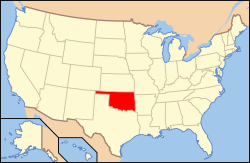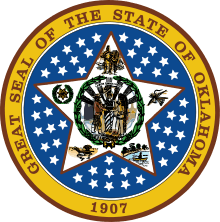Beaver County, Oklahoma
| Beaver County, Oklahoma | |
|---|---|
|
Rural Beaver County | |
 Location in the U.S. state of Oklahoma | |
 Oklahoma's location in the U.S. | |
| 36°45′N 100°29′W / 36.75°N 100.48°WCoordinates: 36°45′N 100°29′W / 36.75°N 100.48°W | |
| Founded | 1890 |
| Seat | Beaver |
| Largest town | Beaver |
| Area | |
| • Total | 1,818 sq mi (4,709 km2) |
| • Land | 1,815 sq mi (4,701 km2) |
| • Water | 2.8 sq mi (7 km2), 0.2% |
| Population (est.) | |
| • (2013) | 5,566 |
| • Density | 3.1/sq mi (1.2/km2) |
| Congressional district | 3rd |
| Time zone | Central: UTC−6/−5 |
| Website |
beaver |
Beaver County is a county located in the U.S. state of Oklahoma. As of the 2010 census, the population was 5,636.[1] The county seat is Beaver.[2] The name was given because of the presence of many beaver dams on the Beaver River, which runs through the area.[3] It is located in the Oklahoma Panhandle.
History
The land where Beaver County is located has been under several jurisdictions. At one time, it was part of Mexico and then Texas before Texas became a state of the United States. Then in the Compromise of 1850, Texas ceded the land that would eventually become the Oklahoma panhandle to the United States government.[4] The area was known as "No Man's Land" because it belonged to no state or territorial government.[4] There was a period of time (1886 - 1890) during which it was a separate organized territory, known as Cimarron Territory.[5] After becoming part of the Oklahoma Territory in 1890, Beaver County (first called Seventh County) covered the entire Oklahoma Panhandle.[5] At statehood in 1907, Cimarron County was taken from the western one-third, while Texas County was taken from the middle, leaving Beaver County only in the east.[4] Its borders are now at 100°W (east), 37°N (north), 36.5°N (south), and approximately 100.8°W (west).
Geography
According to the U.S. Census Bureau, the county has a total area of 1,818 square miles (4,710 km2), of which 1,815 square miles (4,700 km2) is land and 2.8 square miles (7.3 km2) (0.2%) is water.[6] It is the fifth-largest county in Oklahoma by area.
Just north of the town of Beaver is the Beaver Dunes State Park.
Major highways
Adjacent counties
- Meade County, Kansas (north)
- Clark County, Kansas (northeast)
- Harper County (east)
- Ellis County (southeast)
- Lipscomb County, Texas (south)
- Ochiltree County, Texas (southwest)
- Texas County (west)
- Seward County, Kansas (northwest)
Demographics
| Historical population | |||
|---|---|---|---|
| Census | Pop. | %± | |
| 1900 | 3,051 | — | |
| 1910 | 13,631 | 346.8% | |
| 1920 | 14,048 | 3.1% | |
| 1930 | 11,452 | −18.5% | |
| 1940 | 8,648 | −24.5% | |
| 1950 | 7,411 | −14.3% | |
| 1960 | 6,965 | −6.0% | |
| 1970 | 6,282 | −9.8% | |
| 1980 | 6,806 | 8.3% | |
| 1990 | 6,023 | −11.5% | |
| 2000 | 5,857 | −2.8% | |
| 2010 | 5,636 | −3.8% | |
| Est. 2016 | 5,382 | [7] | −4.5% |
| U.S. Decennial Census[8] 1790-1960[9] 1900-1990[10] 1990-2000[11] 2010-2013[1] | |||

As of the 2010 census, there were a total of 5,636 people, 2,192 households, and 1,614 families in the county.[12] The population density was 3 people per square mile (1/km²). There were 2,719 housing units at an average density of 2 per square mile (1/km²). The racial makeup of the county was 92.71% White, 0.29% Black or African American, 1.25% Native American, 0.10% Asian, 0.03% Pacific Islander, 3.76% from other races, and 1.86% from two or more races. 10.76% of the population were Hispanic or Latino of any race.
There were 2,245 households out of which 33.50% had children under the age of 18 living with them, 66.30% were married couples living together, 6.10% had a female householder with no husband present, and 24.00% were non-families. 22.00% of all households were made up of individuals and 12.30% had someone living alone who was 65 years of age or older. The average household size was 2.57 and the average family size was 2.99.
In the county, the population was spread out with 26.80% under the age of 18, 6.50% from 18 to 24, 25.80% from 25 to 44, 24.10% from 45 to 64, and 16.90% who were 65 years of age or older. The median age was 39 years. For every 100 females there were 102.20 males. For every 100 females age 18 and over, there were 100.90 males.
The median income for a household in the county was $36,715, and the median income for a family was $41,542. Males had a median income of $31,013 versus $20,162 for females. The per capita income for the county was $17,905. About 8.80% of families and 11.70% of the population were below the poverty line, including 15.80% of those under age 18 and 7.80% of those age 65 or over.
Politics
| Voter Registration and Party Enrollment as of January 15, 2018[13] | |||||
|---|---|---|---|---|---|
| Party | Number of Voters | Percentage | |||
| Democratic | 492 | 16.50% | |||
| Republican | 2,226 | 74.67% | |||
| Others | 263 | 8.82% | |||
| Total | 2,981 | 100% | |||
Although at one time competitive, Beaver has become strongly Republican in Presidential elections. The last Democratic candidate to win the county was Harry Truman in 1948.[14] In the last three Presidential elections the Republican candidate has consistently received over 85% of the county's vote.[15]
It is part of Oklahoma's 3rd congressional district and as such is represented by Frank Lucas. In the Oklahoma Senate it is part of the 27th district and is represented by Republican Bryce Marlatt. In the Oklahoma House of Representatives it is part of the 61st district and is represented by Republican Gus Blackwell.
| Year | Republican | Democratic | Third parties |
|---|---|---|---|
| 2016 | 88.9% 1,993 | 7.9% 176 | 3.3% 74 |
| 2012 | 89.4% 2,062 | 10.6% 244 | |
| 2008 | 89.3% 2,199 | 10.8% 265 | |
| 2004 | 88.4% 2,272 | 11.6% 297 | |
| 2000 | 85.2% 2,092 | 13.8% 339 | 1.0% 25 |
| 1996 | 72.5% 1,893 | 19.7% 515 | 7.8% 203 |
| 1992 | 59.6% 1,699 | 20.4% 580 | 20.0% 571 |
| 1988 | 71.0% 2,013 | 27.4% 777 | 1.6% 44 |
| 1984 | 82.7% 2,689 | 16.5% 536 | 0.8% 27 |
| 1980 | 75.5% 2,430 | 21.6% 696 | 2.9% 92 |
| 1976 | 58.8% 1,801 | 39.6% 1,213 | 1.5% 47 |
| 1972 | 80.4% 2,562 | 16.4% 522 | 3.2% 102 |
| 1968 | 68.7% 2,114 | 20.3% 624 | 11.0% 339 |
| 1964 | 56.8% 1,982 | 43.2% 1,508 | |
| 1960 | 73.4% 2,442 | 26.6% 887 | |
| 1956 | 68.4% 2,046 | 31.6% 946 | |
| 1952 | 75.6% 2,539 | 24.4% 819 | |
| 1948 | 47.1% 1,420 | 52.9% 1,596 | |
| 1944 | 58.1% 1,913 | 41.1% 1,355 | 0.8% 27 |
| 1940 | 51.8% 2,219 | 47.5% 2,034 | 0.7% 29 |
| 1936 | 34.7% 1,340 | 64.8% 2,502 | 0.5% 21 |
| 1932 | 34.7% 1,358 | 65.3% 2,553 | |
| 1928 | 73.7% 2,596 | 25.2% 887 | 1.2% 41 |
| 1924 | 49.4% 1,565 | 37.7% 1,195 | 12.9% 407 |
| 1920 | 60.0% 1,973 | 32.7% 1,076 | 7.3% 240 |
| 1916 | 32.9% 913 | 49.8% 1,382 | 17.3% 479 |
| 1912 | 42.8% 1,070 | 37.0% 926 | 20.3% 507 |
Economy
Beaver County's economy has largely been based on agriculture since the turn of the 20th Century. At first, the major crop was broomcorn, but that was overtaken by wheat in the 1920s. Railroads connected the county to agricultural markets and stimulated an influx of new farmers. Beginning in 1912, the Wichita Falls and Northwestern Railway built a line from Woodward through Gate to Forgan. Beaver, Meade and Englewood Railroad completed a spur in 1915 from Beaver to Forgan, which was extended westward in 1925 -1927 to Hooker. New towns arose along the rail lines or old ones relocated along them.[5]
Communities
Towns
Census-designated place
Unincorporated communities
Cemeteries
Meridian Cemetery
Meridian Cemetery is a cemetery that is located at 36°46′1.7″N 100°00′26.9″W / 36.767139°N 100.007472°W in Beaver County, Oklahoma. There are many unmarked graves and many lost graves.[17]
Originally known as Cline Cemetery, established sometime in 1893 to 1894, named after the City of Cline, Oklahoma, which is now a ghost town, was sold to Meridian Cemetery Assn. in 1908. It was land originally owned by Phillip Huret Jr. It was started approximately in 1893 or 1894. It consists of 2 acres of land. In 1908 it was sold for $150$ to the Meridian Cemetery Association.[18]
NRHP sites
The following sites in Beaver County are listed on the National Register of Historic Places:
|
|
Further reading
- Gould,, Charles Newton (1926). Geology of Beaver county, Oklahoma, by Chas. N. Gould and John T. Lonsdale. Fossil leaves from Beaver county, by E. W. Berry. Agriculture of Beaver county, by Ernest Slocum. History of Beaver county, by F. C. Tracy. Norman, Oklahoma. LCCN gs26000324.
- A History of Beaver County. Beaver, Oklahoma: Beaver County Historical Society. 1970–71. LCCN 70021830. 2 v. illus. (part col.) 32 cm.
References
- 1 2 "State & County QuickFacts". United States Census Bureau. Retrieved November 8, 2013.
- ↑ "Find a County". National Association of Counties. Archived from the original on July 12, 2012. Retrieved June 7, 2011.
- ↑ Chronicles of Oklahoma. "Origin of County Names in Oklahoma." v. 2, N, 1. March 1924. Retrieved May 26, 2013.
- 1 2 3 Turner, Kenneth R."No Man's Land," Encyclopedia of Oklahoma History and Culture, 2009. Accessed March 28, 2015.
- 1 2 3 Hodges, V. Pauline. "Beaver County," Encyclopedia of Oklahoma History and Culture, 2009. Accessed March 28, 2015.
- ↑ "2010 Census Gazetteer Files". United States Census Bureau. August 22, 2012. Retrieved February 18, 2015.
- ↑ "Population and Housing Unit Estimates". Retrieved June 9, 2017.
- ↑ "U.S. Decennial Census". United States Census Bureau. Archived from the original on May 12, 2015. Retrieved February 18, 2015.
- ↑ "Historical Census Browser". University of Virginia Library. Retrieved February 18, 2015.
- ↑ Forstall, Richard L., ed. (March 27, 1995). "Population of Counties by Decennial Census: 1900 to 1990". United States Census Bureau. Retrieved February 18, 2015.
- ↑ "Census 2000 PHC-T-4. Ranking Tables for Counties: 1990 and 2000" (PDF). United States Census Bureau. April 2, 2001. Retrieved February 18, 2015.
- ↑ American FactFinder Archived September 11, 2013, at the Wayback Machine., United States Census Bureau. (accessed September 4, 2013)
- ↑ https://www.ok.gov/elections/documents/20180115%20-%20Registration%20By%20County%20%28vr2420%29.pdf
- ↑ Geographie Electorale
- ↑ The New York Times electoral map (Zoom in on Oklahoma)
- ↑ Leip, David. "Dave Leip's Atlas of U.S. Presidential Elections". uselectionatlas.org. Retrieved March 28, 2018.
- ↑ "Meridian Cemetery — Cemetery in Laverne, OK". All US Churches in AllUSChurches.com. Retrieved 2017-12-27.
- ↑ A History of Beaver County, Vol. 2 (Beaver, Okla.: Beaver County Historical Society, Inc., 1971). Beaver, Oklahoma: Beaver County Historical Society. 1971. pp. 111, 112.
External links
- Hodges, V. Pauline. "Beaver County," Encyclopedia of Oklahoma History and Culture, 2009. Accessed March 18, 2015.
- Beaver County Government site
- McCasland Digital Collection of Early Oklahoma and Indian Territory Maps
